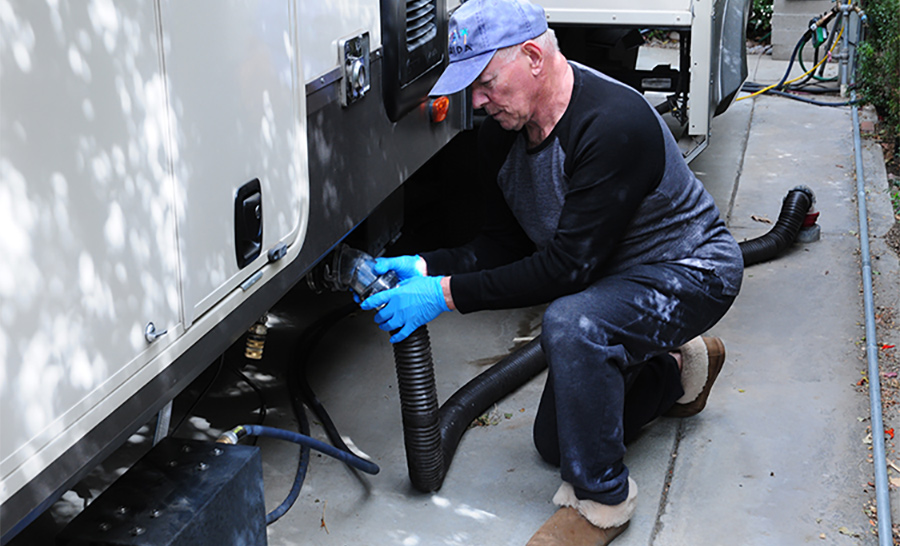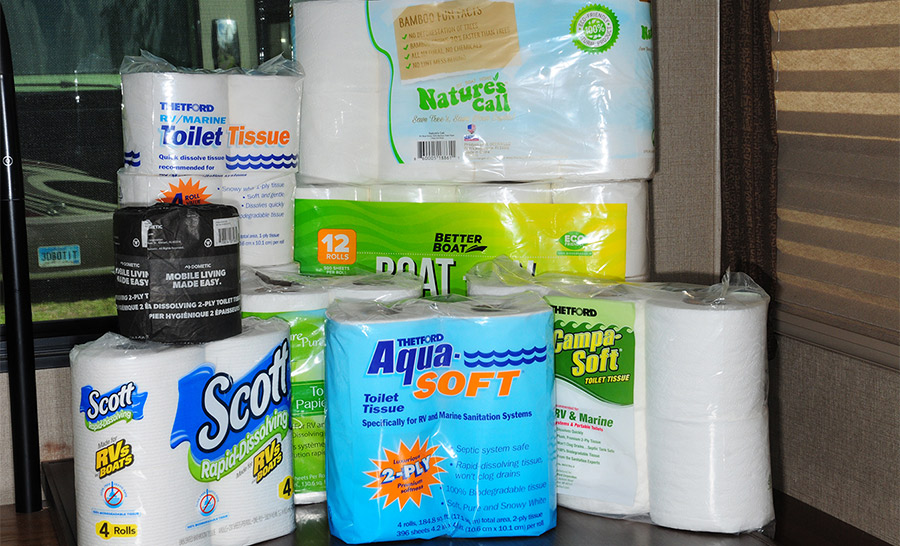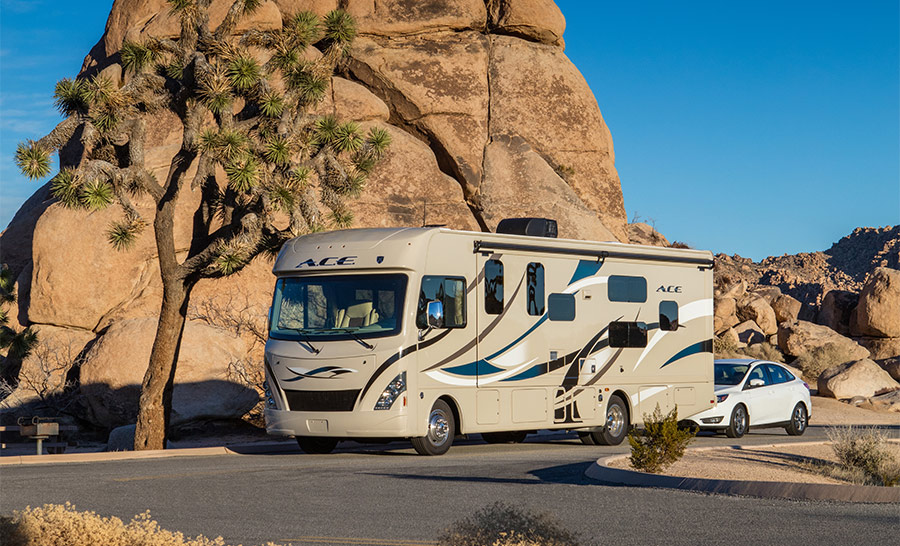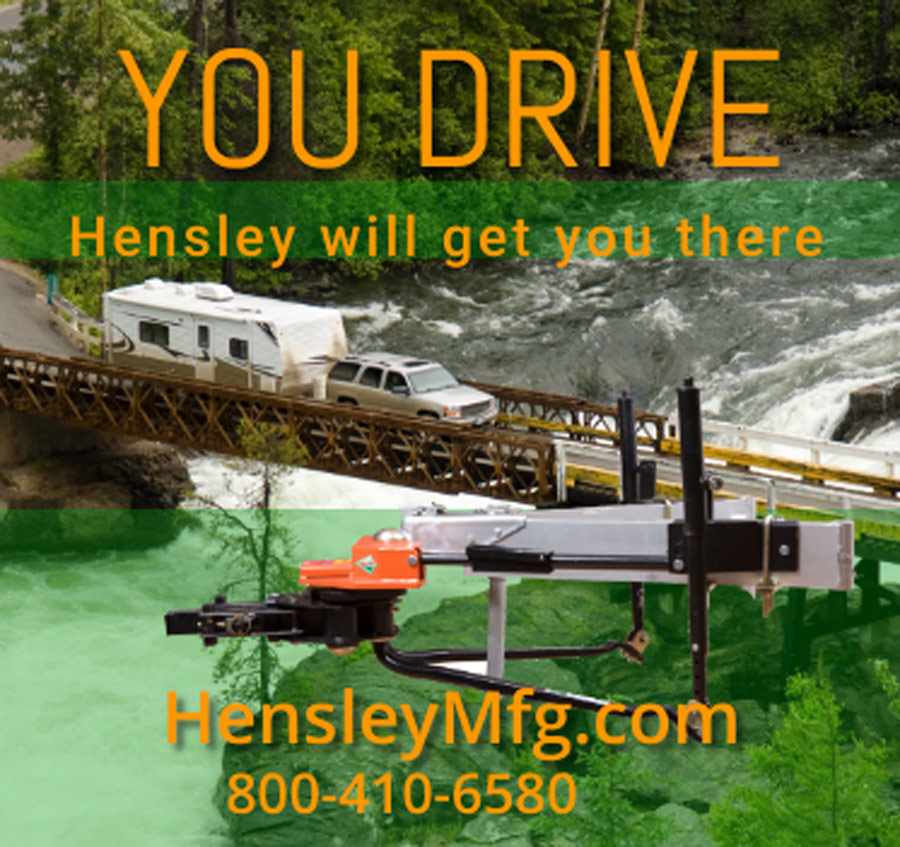Subscriber Access Only
Special Offer
Get 1 year of RV Enthusiast Magazine for just $9.99
Unlock My Offer No ThanksAlready a subscriber? Click here to access full issues.



Social Distancing Machine!







Make it a Lance. We are social distancing pros with 55+ years of experience building RVs. Unmatched quality achieved through composite construction and lightweight design with off the grid features keeping you powered up and connected with family and friends.
Our dealer partners are open and ready to serve you in a safe environment! LIVE.LANCE.LIFE.

Keystone RV developed a proprietary chassis for its Arcadia — then gave the new fifth wheel and travel trailer brand a unique forward-leaning shape to go with it.
Campers Inn RV’s new Quality Center in Elkhart County, Indiana, puts RVs through an extensive examination long before they head off to dealership locations.
Plumbing technology has advanced significantly for RVs. Modern materials make it easier to repair plumbing problems while on the road.
Dealing with holding tanks will never rank high on an RVer’s popularity chart, but neither do they have to be the nastiest part of RVing.
Two gripes most travelers have when showering in an RV are water pressure and hard water. Here’s one way to deal with both aggravations.
Toilet paper is at the center of many black-water tank problems, so we tested and ranked 9 popular RV toilet tissue brands to find what works best.

Towing a car, truck or SUV behind your motorhome makes travel more convenient and enjoyable — but not every vehicle can be flat-towed.
Towing a vehicle requires a hard connection between the motorhome and dinghy. The base plate is the first thing to add; here’s how to find and install one.
There’s more to towing a vehicle behind a coach than hard connections — the dinghy’s electrical system also has to be modified for safe, legal travel.
A dinghy can tax a motorhome’s stopping power, which is why a supplementary braking system for the towed vehicle is mandatory in all but one state.
A handy guide to discussing potential issues RVers may be confronted with when towing a vehicle behind a motorhome — and how to solve them.
(800) 830-9729 ext. 3
[email protected]
EDITOR – Bruce Hampson
(574) 584-4616
[email protected]
TECHNICAL DIRECTOR
Chris Dougherty
(800) 830-9729 ext. 5
[email protected]
TECHNICAL EDITOR – Chris Hemer
(800) 830-9729 ext. 6
[email protected]
SOCIAL MEDIA DIRECTOR – Jim Mac
(800) 830-9729 ext. 7
[email protected]
ART DIRECTOR – MIKE ACCUARDI
[email protected]
120 Atwater Road, Springfield, MA 01107
Sue Seidlitz
(800) 830-9729 ext. 2
[email protected]
ADVERTISING SALES
LORISA PIERSON
(800) 830-9729 EXT. 8
[email protected]
RV Enthusiast is published monthly by RVE Media Group Inc., 3425 East Golden Valley Road, Reno, NV 89506. RV Enthusiast magazine is copyrighted in the United States, Canada, Great Britain and other countries.© 2021 RVE Media Group All rights reserved. Permission to reprint or quote excerpts considered on an individual basis and granted only by written request. Advertising rates and Editorial calendars provided upon request at https://rventhusiast.com/advertise. Opinions expressed in RV Enthusiast are those of the author and not necessarily those of RVE Media Group LLC. Be sure to further research any product, service, or project seen in RVE before installing on your RV. Always use safe working practices, and if you’re not comfortable, consult an RV service professional.
 AFFILIATE NOTICE: RVE Media Group LLC provides links to vendors and products, such as an Amazon Associates account, for informational purposes, but that may provide a commission if you purchase from that link. We often label these links with language that provides transparency if the destination is an advertiser, affiliate, or partner. Products are often provided to RVE at little/no cost for editorial testing purposes by vendors/suppliers. Under no circumstances does this affect the results of the test or install as published in RV Enthusiast. Sponsored content is identified as such directly on the content.
AFFILIATE NOTICE: RVE Media Group LLC provides links to vendors and products, such as an Amazon Associates account, for informational purposes, but that may provide a commission if you purchase from that link. We often label these links with language that provides transparency if the destination is an advertiser, affiliate, or partner. Products are often provided to RVE at little/no cost for editorial testing purposes by vendors/suppliers. Under no circumstances does this affect the results of the test or install as published in RV Enthusiast. Sponsored content is identified as such directly on the content.
PRIVACY POLICY: Our complete privacy policy can be found at https://rventhusiast.com/privacy-policy/



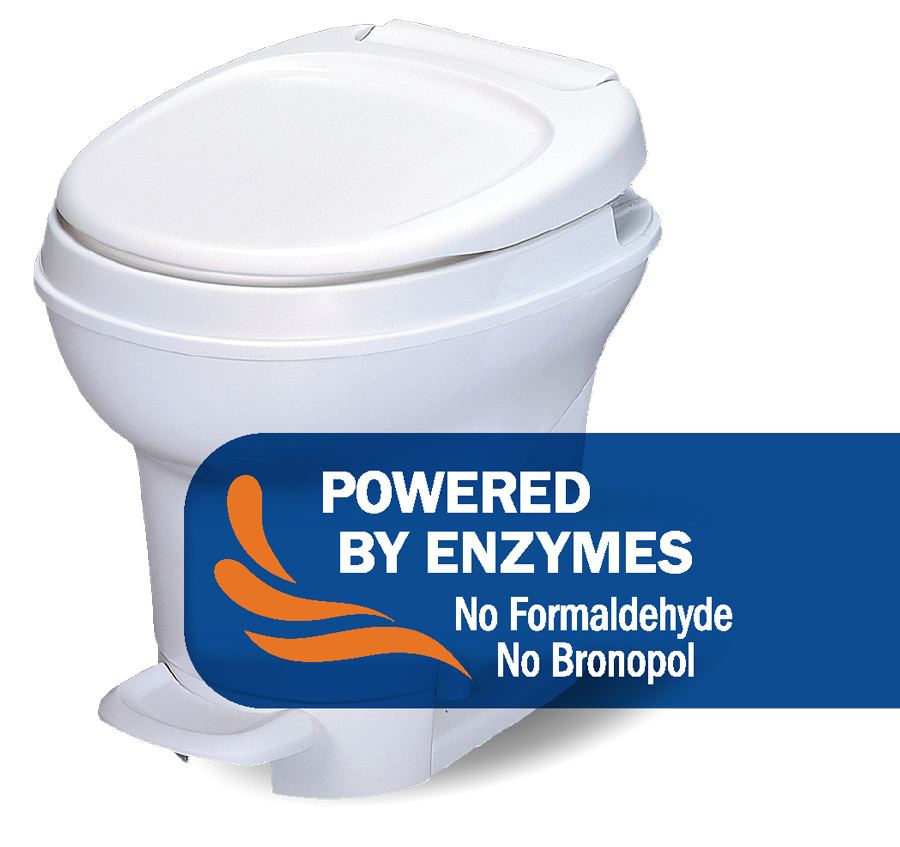




t was supposed to be a trip destined to make memories. Granted, all journeys oftentimes lend themselves to creating stories for one’s personal memoirs, but this one was special: It was to celebrate not only the 50th anniversary of Bob and Lynne Livingston’s marriage but also Bob’s 50th year in the RV industry.
To say it hasn’t worked out quite the way it was envisioned would be something of an understatement.
Let me preface this by saying that Bob is easily one of the most technically knowledgeable journalists on the planet. For decades he oversaw the nuts-and-bolts story lines that appeared in both Trailer Life and MotorHome magazines and authored Trailer Life’s RV Repair & Maintenance Manual which, when printed and for years afterward, was considered the authority on RV repair for the do-it-yourself crowd. He’s also one of four experienced RV journalists who came together to create RV Enthusiast magazine. Suffice to say, he knows his stuff.

The extensive Togo RV Plus program provides members with the list of features available at no cost to anyone using its Togo Free program as well as a host of valuable additions. The upscale program, available for $39.99 annually, includes GPS navigation customized for your RV; a 25% lifetime discount on Harvest Hosts’ popular annual membership; premium trip planning with Roadtrippers Plus; unlimited access to boondocking locations using OvernightRVParking.com; major savings on favorite RV brands, tires and more. It also offers gold-status membership to RVillage, one of the RV industry’s top social networks.


This results in an entirely different driving experience when you’re towing your moving house. More control. More comfort. More vacation.
Zero-maintenance.
Backed by a lifetime warranty.


remember one of my first staff RV outings when I was overseeing the editorial content of MotorHome magazine many years back. Those of us who could go — as well as a few friends and family members — spent a long weekend at Pismo Coast Village, one of a number of campgrounds along the California coast just south of San Luis Obispo. I don’t recall the RV I used for the weekend, other than it was a hybrid travel trailer that I shared with my son and two of his friends.
What I do recollect, however, was how my publisher laughed when he entered the trailer and saw me cooking breakfast in an electric skillet. This, apparently, wasn’t “roughing it,” although I had the last laugh: when we weren’t barbequing, I cooked everything in that skillet, to no complaints. As a bachelor, I’d developed a decent repertoire of one-pot (or one-skillet) meals — and one-pot cleanups.

remember one of my first staff RV outings when I was overseeing the editorial content of MotorHome magazine many years back. Those of us who could go — as well as a few friends and family members — spent a long weekend at Pismo Coast Village, one of a number of campgrounds along the California coast just south of San Luis Obispo. I don’t recall the RV I used for the weekend, other than it was a hybrid travel trailer that I shared with my son and two of his friends.
What I do recollect, however, was how my publisher laughed when he entered the trailer and saw me cooking breakfast in an electric skillet. This, apparently, wasn’t “roughing it,” although I had the last laugh: when we weren’t barbequing, I cooked everything in that skillet, to no complaints. As a bachelor, I’d developed a decent repertoire of one-pot (or one-skillet) meals — and one-pot cleanups.

People who spend a lot of time outdoors — like those who are reading this article — should be well aware of the hazards that dangerous weather can bring. This is especially important in certain parts of the country, but during the summer the weather can change quickly across much of the country. We wanted to take this opportunity to give an overview of the National Weather Service’s (NWS) products and services and to give some information on lightning safety.

First, let’s provide a few critical definitions:
Thunderstorm — A cumulonimbus cloud that becomes electrically charged and produces lightning. Lightning quickly heats the air around it to 50,000 degrees which causes a rapid expansion of that air. Thunder is the sound we hear due to that expansion.
Severe Thunderstorm — A thunderstorm that produces either a wind gust in excess of 58 mph or hail that is 1” in diameter (size of a quarter) or larger, or both. Severe thunderstorms can occasionally spawn a tornado.
V construction — the actual building of an RV as opposed to the perceived quality of that build — doesn’t typically crop up in conversations around the campfire. There’s a good reason why: Much of an RV’s requisite systems are hidden from sight behind wallboards, ceilings, floors and underbelly protection. Owners enjoy the final results, from entertainment centers and onboard electronics to sinks, showers and toilets without having to deal with the constraints manufacturers encountered while installing such systems.


ringing a dinghy (or “towed”) vehicle along for your motorhome journeys is a popular practice among RVers — and one that can make traveling much more convenient when you arrive at your destination. Once you’re all set up with the motorhome’s awning out and the jacks down, it’s simply a matter of jumping in your dinghy vehicle when you want to explore the surroundings or visit friends and family. Plus, there are no concerns over where or how you might park when you get there, which reduces stress and provides greater freedom for your travel plans.
While the process of towing a vehicle with all four of its wheels on the ground isn’t difficult, choosing the right dinghy vehicle for your needs requires some research and planning on your part to make sure the vehicle you own — or wish to purchase — is suitable for dinghy towing.
Since your motorhome will be doing all of the heavy lifting, the first step is to verify its tow rating. A large gas or diesel Class A may not have difficulty towing most vehicles but a smaller Class C may have a limited tow rating, so be sure to check with the chassis or coach manufacturer first. The weight of the dinghy vehicle you are considering, meanwhile, should be available on the vehicle manufacturer’s website under “specifications.”
photos by the author
nce you have verified that the vehicle you plan to tow behind your motorhome is, in fact, towable, the first step toward outfitting it for dinghy duty is the base plate. Unlike a travel trailer — which was designed to be attached behind another vehicle — a car, truck or SUV was never intended to be towed for recreational purposes. So, the baseplate serves as the attachment point for a tow bar, which is most connected to the motorhome via its hitch receiver when you’re ready to tow.

photos by the author


nce you have verified that the vehicle you plan to tow behind your motorhome is, in fact, towable, the first step toward outfitting it for dinghy duty is the base plate. Unlike a travel trailer — which was designed to be attached behind another vehicle — a car, truck or SUV was never intended to be towed for recreational purposes. So, the baseplate serves as the attachment point for a tow bar, which is most connected to the motorhome via its hitch receiver when you’re ready to tow.
Signals,
Action!



hen planning to tow a vehicle behind a motorhome, keep in mind that you’re essentially turning it into a trailer as far as the law is concerned. It must have an emergency breakaway, its own functioning brake system and lights that work in concert with tow vehicle (in this case, your motorhome) so that drivers behind your dinghy vehicle know when you’re braking, turning, or just have the running lights on.
Unlike a trailer, which already has a wiring harness designed to plug into the tow vehicle (seven or four pin), a car, truck or SUV does not — the electrical system in the dinghy vehicle must be modified so that can be plugged into the motorhome’s electrical system when it’s time to tow. This same harness may also be used to operate a supplemental braking system and/or to keep the dinghy vehicle’s battery charged with the addition of a charge line (more on that later).
Stop



art of an enjoyable, relaxing motorhome journey is being safe in the knowledge that everything is working correctly and you’re ready for just about any eventuality. Having a properly functioning supplementary braking system on the dinghy vehicle should be a big part of your travel preparedness. Unlike a trailer, which has its own dedicated brake system that is energized whenever you plug the power cord into the tow vehicle, your dinghy vehicle’s brakes won’t work unless you install a supplementary system that applies the brakes when the motorhome brakes are applied. There are two basic ways to do this: with a portable system that locates between the vehicle’s driver seat and brake pedal, or a permanently installed system — and there are a variety of choices available. Which do you choose? And perhaps more importantly, are supplementary brakes really necessary?
In a word, “yes.” While it may be true that most motorhomes are capable of stopping with a dinghy vehicle in tow, the question is, how much will braking distance be increased? Obviously, this depends on the motorhome and the weight of the dinghy vehicle in question — but there’s no doubt that you will appreciate all the braking power you can get when you’re heading downhill at 60mph and traffic begins to slow suddenly. Plus, a supplementary braking system will take some of the burden off of your motorhome’s brakes, helping to prevent dreaded brake fade and improving brake life.


lsewhere in this section, we’ve covered the key components you must have in order to tow a dinghy vehicle safely and legally: A baseplate, tow bar, supplementary braking system and modifications to the vehicle’s electrical system. But beyond these must-haves, there is a wide range of accessories available that are designed to make towing your dinghy vehicle more convenient and enjoyable.
Newer vehicles, in particular, require an increasing number of steps to prepare them for towing, most of which involve extra time and can result in some real hassles. For example, many new vehicle owner’s manuals specify that the negative battery cable be disconnected every time you tow, which means that all of your data (time/date, radio presets, etc.) will need to be re-set once you arrive at your destination. In addition, a battery that is disconnected can’t power up a portable braking system, which can create another set of problems. In other cases, the manufacturer may specify that certain fuses be removed before towing — and you can just imagine the fun of breaking or losing the fuses for your vehicle when you’re miles away from anywhere on a Sunday afternoon.
Photos by the author
s anyone who owns an RV knows, the pandemic that fueled a rediscovery of the camping lifestyle has also intensified a few shortcomings that have plagued the industry for years. The inability of finding a last-minute site at a popular campground is one perennial angst chart-topper for weary travelers — and being able to locate a service shop that can provide emergency RV repairs is another. While dealers, suppliers and the industry itself are addressing a shortage of service technicians, most repair facilities nonetheless have an appointment schedule oftentimes stretching for months into the future.


he modern amenities we enjoy in today’s RVs almost always follow the trends found in residential applications, from design aesthetics to electronics and, yes, plumbing. During the past 100 years, plumbing technology in RVs has progressed from using copper and galvanized pipe and tanks to today’s cross-linked polyethylene, or PEX, plumbing, residential style fixtures and instant, on-demand, endless hot water.




he modern amenities we enjoy in today’s RVs almost always follow the trends found in residential applications, from design aesthetics to electronics and, yes, plumbing. During the past 100 years, plumbing technology in RVs has progressed from using copper and galvanized pipe and tanks to today’s cross-linked polyethylene, or PEX, plumbing, residential style fixtures and instant, on-demand, endless hot water.
In this article, we’re presenting information about the freshwater plumbing system. We’ll delve into the waste system in a later issue.
aving grown up with RVing from the early 1970’s, I never experienced many RV potty problems. Basic mechanics, a farm upbringing and science got me through quite well. It wasn’t until I started working as a technician that I realized what a problem there was with all this crap (pun absolutely intended). As it turns out, when you take folks who have known nothing but a flush toilet, add any kind of paper that the TV commercials say is “soft and strong” and introduce them to a system they have to interact with…well, you have a potential problem.



aving grown up with RVing from the early 1970’s, I never experienced many RV potty problems. Basic mechanics, a farm upbringing and science got me through quite well. It wasn’t until I started working as a technician that I realized what a problem there was with all this crap (pun absolutely intended). As it turns out, when you take folks who have known nothing but a flush toilet, add any kind of paper that the TV commercials say is “soft and strong” and introduce them to a system they have to interact with…well, you have a potential problem.
The System
For people who are new to the lifestyle — and to serve as a review for the folks who have been around it for a while — wastewater in an RV is generally separated into liquid waste (grey water) and a mix of solid and liquid waste (black water). Most of the time, sinks, showers, clothes washers and dishwashers drain into one or more grey water tanks in the RV via 1-½ inch black ABS pipe. Occasionally, systems in small RVs will have a single tank to capture black and grey water, but this is rare and frankly a less than ideal setup. Imagine the shower drain backing up because the single holding tank is full. Not a pretty picture.





aking a shower in an RV is not exactly exotic. Most showerheads push out a boring stream of water, designed to get the job done with little fanfare. Multiple showerheads or a rainforest fixture can up the entertainment factor appreciably but adding such hardware may not be possible without major modifications to your rig. And even if the accoutrements in your shower invite lingering, water consumption plays a pivotal role — and don’t forget the limitations on hot water capacity (unless, of course, you have an instantaneous model like Truma’s AquaGo). Ecocamel, though, offers a number of products that restore luxury to showering in RVs.
The London, England-based company’s most interesting product is the Orbit SoftWater, a showerhead that combines a unique soft-water feature with multiple spray nozzles in a ring-shaped head. While it’s nice to have a strong stream of water that covers the body while showering, the soft-water portion targets a common problem for RVers: calcium damage introduced by hard water that can build up in water lines.


V owners have a love-hate relationship with their holding tanks. Usually, the most problematic of these is the black tank — a waste receptacle which can clog, create havoc with the monitor sensors and (as we’ve probably all discovered on occasion) emit terrible odors. If you’re looking for answers to why these tanks cause so much pain, just look in the mirror. Owners are known to neglect regular maintenance, introduce the wrong type of toilet paper — and use too much of it — fail to add proper chemicals and follow erroneous dumping procedures. The Internet is full of reasons why these tanks create stress among owners, but many of the “solutions” are technically inaccurate and will themselves lead to additional problems.
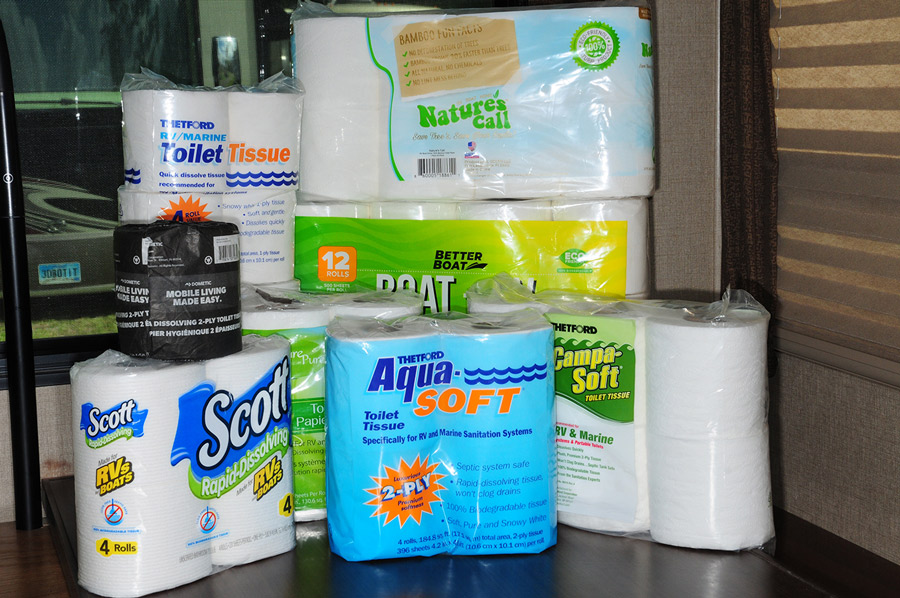

V owners have a love-hate relationship with their holding tanks. Usually, the most problematic of these is the black tank — a waste receptacle which can clog, create havoc with the monitor sensors and (as we’ve probably all discovered on occasion) emit terrible odors. If you’re looking for answers to why these tanks cause so much pain, just look in the mirror. Owners are known to neglect regular maintenance, introduce the wrong type of toilet paper — and use too much of it — fail to add proper chemicals and follow erroneous dumping procedures. The Internet is full of reasons why these tanks create stress among owners, but many of the “solutions” are technically inaccurate and will themselves lead to additional problems.
Hence, The Great Wipeoff, wherein yours truly and three companion RVers “took one for the team” by overeating for a few days in order to fully assess the abilities of a variety of tissue types meant to keep us happy while on the road.

Sometimes, little things take on an oversize importance — like trying to attach a freshwater hose between your RV and the campsite water spigot. The solution? The folks at J. Wright Concepts developed the Hose-Grip, an 8-inch assembly that attaches easily to any RV water hose. The ergonomic design of the Grip makes attaching and removal of the hose at the faucet a breeze for anyone with limited hand dexterity. The Grip features nickel-plated male and female fittings combined with a hydraulically crimped Water Right polyurethane hose with a burst pressure of more than 300 psi, exceeding virtually all pressure standards you might find in your travels. There also are 3- and 6-foot versions available, which work great for customers who use an inline water filter. J Wright Concepts, (916) 955-0048, https://rvcablegrip.com

few years ago, while traveling through South Carolina, my husband and I discovered what USA Today named in 2018 “America’s Best Coastal Small Town” — Georgetown, South Carolina. Georgetown is located in the center of South Carolina’s beautiful Hammock Coast and is just one hour north of Charleston and 30 minutes south of Myrtle Beach on Highway 17. This small coastal town has more 200-year-old homes than Charleston along with scenic plantations, a rich history and lots of Southern charm — and it has none of the crowds that you find in Charleston or Myrtle Beach.
Recognized as the third-oldest city in the United States, Georgetown is located on Winyah Bay and is at the convergence of five rivers: the Black River, Small Pee Dee and Great Pee Dee rivers, and the Waccamaw and Sampit rivers. The earliest residents of the Georgetown area were Native American tribes, which are responsible for many of the names of the rivers and natural features around this region. In the 1520s, European explorers from Spain discovered this seaport area, later followed by English and French settlements along the five rivers. The city of Georgetown was officially established as a “trading post” and seaport in 1729 (it is, today, the second-largest seaport in South Carolina). As trade with the Native American tribes declined, residents developed large plantations and cultivated indigo and rice. By the mid-1700s, Georgetown exported more rice than any port in the world.








